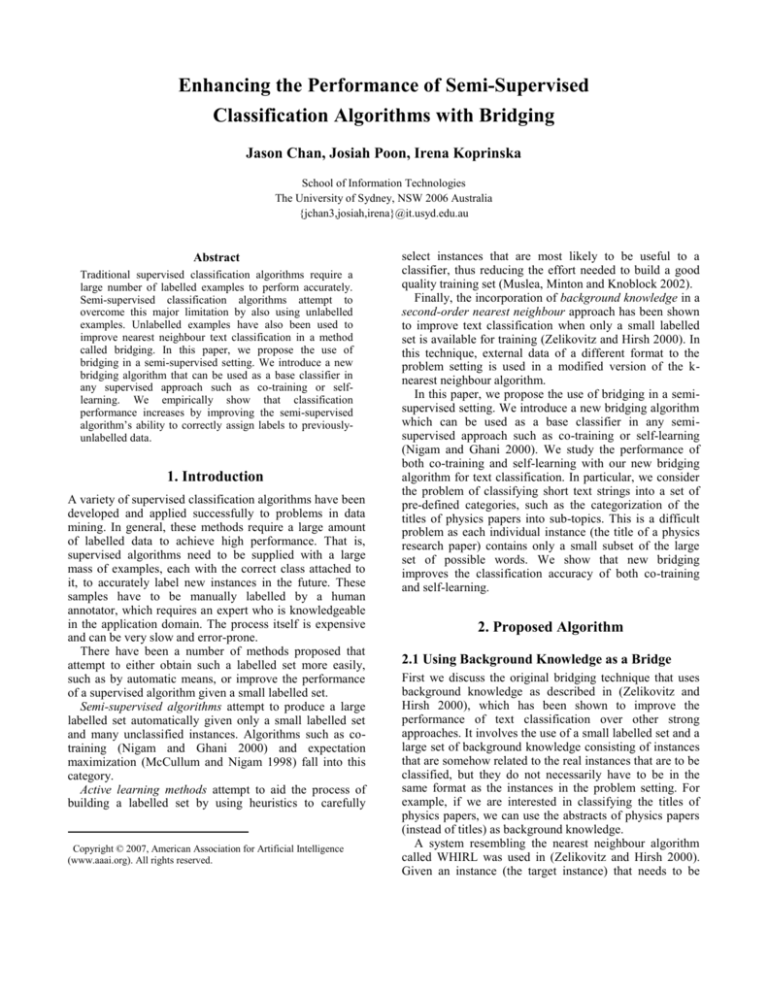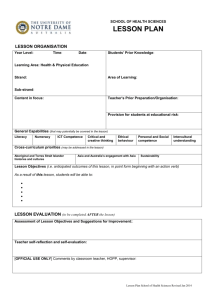
Enhancing the Performance of Semi-Supervised
Classification Algorithms with Bridging
Jason Chan, Josiah Poon, Irena Koprinska
School of Information Technologies
The University of Sydney, NSW 2006 Australia
{jchan3,josiah,irena}@it.usyd.edu.au
Abstract
Traditional supervised classification algorithms require a
large number of labelled examples to perform accurately.
Semi-supervised classification algorithms attempt to
overcome this major limitation by also using unlabelled
examples. Unlabelled examples have also been used to
improve nearest neighbour text classification in a method
called bridging. In this paper, we propose the use of
bridging in a semi-supervised setting. We introduce a new
bridging algorithm that can be used as a base classifier in
any supervised approach such as co-training or selflearning. We empirically show that classification
performance increases by improving the semi-supervised
algorithm’s ability to correctly assign labels to previouslyunlabelled data.
1. Introduction
A variety of supervised classification algorithms have been
developed and applied successfully to problems in data
mining. In general, these methods require a large amount
of labelled data to achieve high performance. That is,
supervised algorithms need to be supplied with a large
mass of examples, each with the correct class attached to
it, to accurately label new instances in the future. These
samples have to be manually labelled by a human
annotator, which requires an expert who is knowledgeable
in the application domain. The process itself is expensive
and can be very slow and error-prone.
There have been a number of methods proposed that
attempt to either obtain such a labelled set more easily,
such as by automatic means, or improve the performance
of a supervised algorithm given a small labelled set.
Semi-supervised algorithms attempt to produce a large
labelled set automatically given only a small labelled set
and many unclassified instances. Algorithms such as cotraining (Nigam and Ghani 2000) and expectation
maximization (McCullum and Nigam 1998) fall into this
category.
Active learning methods attempt to aid the process of
building a labelled set by using heuristics to carefully
Copyright © 2007, American Association for Artificial Intelligence
(www.aaai.org). All rights reserved.
select instances that are most likely to be useful to a
classifier, thus reducing the effort needed to build a good
quality training set (Muslea, Minton and Knoblock 2002).
Finally, the incorporation of background knowledge in a
second-order nearest neighbour approach has been shown
to improve text classification when only a small labelled
set is available for training (Zelikovitz and Hirsh 2000). In
this technique, external data of a different format to the
problem setting is used in a modified version of the knearest neighbour algorithm.
In this paper, we propose the use of bridging in a semisupervised setting. We introduce a new bridging algorithm
which can be used as a base classifier in any semisupervised approach such as co-training or self-learning
(Nigam and Ghani 2000). We study the performance of
both co-training and self-learning with our new bridging
algorithm for text classification. In particular, we consider
the problem of classifying short text strings into a set of
pre-defined categories, such as the categorization of the
titles of physics papers into sub-topics. This is a difficult
problem as each individual instance (the title of a physics
research paper) contains only a small subset of the large
set of possible words. We show that new bridging
improves the classification accuracy of both co-training
and self-learning.
2. Proposed Algorithm
2.1 Using Background Knowledge as a Bridge
First we discuss the original bridging technique that uses
background knowledge as described in (Zelikovitz and
Hirsh 2000), which has been shown to improve the
performance of text classification over other strong
approaches. It involves the use of a small labelled set and a
large set of background knowledge consisting of instances
that are somehow related to the real instances that are to be
classified, but they do not necessarily have to be in the
same format as the instances in the problem setting. For
example, if we are interested in classifying the titles of
physics papers, we can use the abstracts of physics papers
(instead of titles) as background knowledge.
A system resembling the nearest neighbour algorithm
called WHIRL was used in (Zelikovitz and Hirsh 2000).
Given an instance (the target instance) that needs to be
classified, the bridging technique works by finding the k
instances in the set of background knowledge that are most
similar to it, where k is a user-specified positive integer.
Similarly, for each of the instances in the small labelled
set, the k most similar unlabelled instances are obtained.
The labelled instances have class labels assigned to them
so that it is possible to assign probabilities of class
membership to the target instance to be classified
according to the class labels of the labelled data and the
similarities between the target instance, the instances in the
background knowledge, and the labelled instances.
The idea behind this method is that with traditional
methods, poor results will be obtained if the target instance
were compared directly to the labelled set, since the
labelled set is so small. It may be very hard to find similar
instances to the target instance, in which case classification
performance will deteriorate. However, if a large dataset of
related background knowledge is used as a bridge between
the target instance and the labelled set, it can be very
useful because there are likely to be many instances that
are similar to both the target instance and the labelled set,
so a connection can be made between the two.
Clearly, for the background knowledge to be useful as a
bridge, it must satisfy certain characteristics. Firstly, the
background knowledge must be related to the test and
labelled instances themselves. Otherwise, it will be
difficult to obtain instances similar to a given target
instance as well as instances in the labelled set.
Secondly, the background knowledge should be large.
Again this is necessary to ensure that instances similar to
the test and labelled set can be obtained.
Thirdly, for best performance, the individual instances
in the background knowledge should contain a sizable
amount of information. That is, a single instance in the
background knowledge should contain more information
than an instance in the labelled or test sets. In (Zelikovitz
and Hirsh 2000), the problem of classifying the titles of
physics papers (which are on average 12 words long) used
abstracts of physics papers (on average 140 words long) in
the background knowledge.
2.2 Bridging in Semi-Supervised Algorithms
The new approach that is introduced in this paper is to
use a technique similar to bridging with background
knowledge and to apply it into semi-supervised algorithms
rather than using only bridging as a classifier or semisupervised algorithms on their own. That is, instead of just
using unlabelled data as examples that can be assigned a
label and hence converted into labelled data, we propose
that the unlabelled data also be used to help assign more
accurate labels to the instance being assigned a class. This
is possible by using the unlabelled data as an intermediary
bridge between the target instance and the labelled set.
Existing semi-supervised algorithms convert labelled
data to unlabelled data by using at least one supervised
classifier. We propose that our new bridging classifier (as
opposed to the original bridging algorithm in section 2.1)
be used in replacement of these supervised classifiers.
Note that we use the unlabelled data as the intermediary
bridge instead of background knowledge. We need to use
unlabelled data instead of background knowledge, because
when our new bridging algorithm is used in a semisupervised algorithm, it will convert the unlabelled data
into labelled training data. As discussed in section 2.1,
background knowledge is more flexible as it is possible to
use other types of data that contain more information than
the instances in the problem space.
Using the unlabelled data may possibly deteriorate
performance of the new supervised classifier because each
individual instance in the unlabelled set now contains less
information in comparison to background knowledge.
However, we expect that the semi-supervised algorithm
will improve in performance because the unlabelled data is
assisting in labelling the unlabelled data. We will compare
the use of background knowledge to unlabelled instances
to see what impact it makes to the performance of the
bridging algorithm on its own, that is, using bridging
simply as a classifier rather than being combined with a
semi-supervised algorithm.
Figures 1 and 2 outline the new bridging algorithm. In
our experiment, the unlabelled set U contains titles instead
of abstracts, since the labelled set L consists of titles.
Input:
L: small labelled set of instances
U: large unlabelled set of instances
t: target instance that we wish to classify
k: a positive integer parameter specified by the user
C: a set of classes to categorize instances in L
Algorithm:
1
Let S(x,c) be the class membership score of any instance x
for class c, cC
2
S(t,c) = 0
3
Find the k nearest instances Ut={ui|i:1..k} in U that are most
similar to t, using a similarity metric (section 3.1)
4
Let mi be the similarity score between t and ui
5
for each instance ui in Ut
6
Find the k nearest instances Lt={lij|i:1..k, j:1..k} in L
that are most similar to ui
7
Let mij be the similarity score between ui and lij
8
for each class c in C
9
for each instance ui in Ut
10
S(ui,c) = 0
11
for each instance lij similar to ui
12
if lij belongs to class c
13
S(ui,c) = S(ui,c) + mij
14 for each class c in C
15
for each instance ui in Ut
16
S(t,c) = S(t,c) + mi. S(ui,c)
17 Normalise S(t,c) over all classes C so that the sum over all
classes is 1
Output:
Normalized class membership scores S(t,c) for test instance t and
all classes c in C
Figure 1. Pseudocode for the new bridging algorithm.
Figure 2. A diagram illustrating the relationships between the
labelled set L, the unlabelled set U, and the target instance t in
the new bridging algorithm.
2.3 Proposed Instance Selection Heuristics
For iterative semi-supervised learning algorithms, an
instance must be selected from the unlabelled set to be
transferred to the labelled set with an assigned label
attached to it. We compared three different instance
selection heuristics to be used in self-learning, a simple
semi-supervised algorithm with just a classifier labelling
unlabelled data and re-training on each iteration.
The most non-zeroes heuristic selects the instance that
contains the most number of attributes with non-zero
value. With this dataset, the instances (titles) do not
contain many words, so those titles that contain even fewer
words will be labelled with less confidence.
In the minimum similarity heuristic, the instance that is
selected for labelling is the one that is least similar to the
current set of instances in the labelled set, that is, the
instance whose sum of similarities with all instances in the
labelled set is the least. The idea is to introduce different
instances into the labelled set so that performance can be
improved in other areas of the learning problem.
The random heuristic is our baseline, which selects an
instance randomly.
3. Experimental Setup
Our experiments consist of two stages. First, we compare
our new bridging algorithm with the original bridging
algorithm as described in (Zelikovitz and Hirsh 2000) to
see how our changes affect classification performance.
In stage two, we test two semi-supervised algorithms,
self-learning and co-training (Nigam and Ghani 2000),
using our new bridging algorithm. Their performance is
evaluated by comparing supervised classification using the
original labelled set with the expanded labelled set that is
produced.
3.1 Dataset Preprocessing
We used a dataset consisting of 953 physics technical
papers, 493 of which belong in the astro-physics category
and 460 in the condensed matter physics class. When
implementing the bridging technique introduced in
(Zelikovitz and Hirsh 2000), we use as background
knowledge 1531 abstracts of physics papers. The entire
dataset is the same as used in (Zelikovitz and Hirsh 2000).
There are a total of 1975 unique words present in the
titles. After applying a stop list to remove common English
words, we used information gain to rank attributes
according to how well they distinguish between the
different classes. We then apply dimensionality reduction
and keep only the 100 most useful attributes. For each of
these attributes, a Boolean value represents whether the
instance has the corresponding word or not.
For our similarity metric that is needed to compare how
similar two strings are, we count the number of attributes
for which both strings have a non-zero value. This
similarity metric is simply the numerator of the Jaccard
coefficient (Tan, Steinbach and Kumar 2006), which is
more suitable when dealing with data with attributes
whose values are typically asymmetric, such as in our case
where the number of zeroes easily outweighs the number
of non-zero values. Separate testing (not shown here)
showed that this was much more effective than using the
regular cosine similarity metric because of the sparse
nature of the dataset.
3.2 Supervised Learning Experiment
We compare the previously proposed original bridging
algorithm using background knowledge (abstracts of
physics papers) with our new bridging algorithm using
instances in the unlabelled set in the same format as those
in the labelled set. We also compare to JRipper, a
conventional supervised algorithm that is an extension of
Ripper, an algorithm that is already considered strong in
this problem setting (Zelikovitz and Hirsh 2000). 5-fold
cross validation is performed so that the test set contains
190 instances, the labelled set consists of 10 instances, and
the remaining titles are used as the unlabelled set.
Performance is measured on the test set using the standard
f1-metric, which is the macro-average of the precision and
recall. We try a variety of k values, using all odd numbers
from 1 to 29 inclusive.
We attempt as best as possible to replicate the algorithm
as introduced in (Zelikovitz and Hirsh 2000) but there are
some noticeable differences. Their system uses WHIRL, a
system with SQL-like queries to obtain the 30 most similar
instances to a given instance, whereas we use a
modification of the k-nearest neighbour algorithm for
various k values. They do not use feature selection,
whereas we have used information gain to keep only the
top 100 attributes. We use Boolean values unlike how they
have used TF-IDF values. However, the most important
characteristics of their algorithm were replicated in our
experiment, in particular, the use of unlabelled data and
background knowledge as a ‘bridge’ to relate target
instances to the labelled data.
In this experiment we evaluate the performance of semisupervised algorithms using new bridging and compare
this to semi-supervised learning without new bridging. We
split the dataset into 5 equal-sized parts, with one part
forming the test set (hence the test set contains 190
instances) and 10 instances from another part forming the
initial labelled set. All other instances are used to form the
initial unlabelled set. We repeat this 5 times so that it
somewhat resembles 5-fold cross validation.
On each iteration of one of the semi-supervised learning
algorithms, an instance is selected and labelled by a new
bridging classifier according to what it thinks is the most
likely label for that instance, then transferred from the
unlabelled set to the labelled set with its newly-assigned
label attached to it. This process continues until the
labelled set reaches a size of 400; further testing showed
that there was no significant improvement for larger set
sizes.
The performance of semi-supervised algorithms is
evaluated by measuring the quality of its expanded
labelled set as follows. For each iteration of a semisupervised algorithm, there exists a labelled set that
contains the originally labelled instances as well as the
instances that have been transferred from the unlabelled set
by the algorithm. This labelled set is used to train a
separate supervised classifier, whose f1 performance
measure is determined on a test set. We decided to use the
original bridging classifier as this supervised classifier to
test the quality of labelled data.
For self-learning, we use various instance-selection
heuristics as described in section 2.3. For the results of the
random selection heuristic, we repeat the experiment 5
times and report the average results. There was generally
little deviation between different runs using the random
selection heuristic.
We also test another semi-supervised algorithm, cotraining (Nigam and Ghani 2000), a more conventional and
well-known semi-supervised algorithm. Briefly, cotraining involves two base classifiers that have access to
the same dataset, but the two classifiers have access to a
disjoint set of attributes. For example, in email
classification, co-training may involve two classifiers, one
of which is only able to ‘look’ at the header information of
the email, while the other classifier is only able to see the
words in the main body of the email. Hence these
classifiers are also known as ‘view’ classifiers because, in
this example, they both ‘see’ the same emails but have
different ‘views’. On each iteration of the algorithm, a
classifier labels an instance from each class that it
considers to be most confident with labelling, and the
classifiers take turns on different iterations. The idea
behind co-training is that by having two view classifiers,
one classifier can confidently label an instance and that
newly labelled instance may help the other classifier who
may not have been so confident to learn the problem task
and vice versa.
In our experiment, we randomly split the features (as
done successfully in (Chan, Koprinska and Poon 2004))
into two equal halves before applying the same feature
selection methods as discussed in section 3.1 to both
halves (resulting in two sets of 100 features). New
bridging is used as the supervised learning algorithm by
co-training for both base classifiers. Co-training transfers
the instance from the unlabelled set that its base classifiers
consider to label with most confidence. In the case of the
new bridging classifier, confidence is determined by the
normalised class membership scores that are output.
These methods are compared to the default method of
self-learning and co-training without new bridging. For
this baseline, we use JRipper as the base classifier. Finally,
we will also compare the semi-supervised algorithms to
simply using a large random sample of 400 instances with
their correct labels. We re-sampled five times to obtain
different sets of 400 instances and took the average
supervised classification results using these five labelled
sets. This will be referred to as the ‘large labelled set’.
4. Experimental Results
4.1 Supervised Classification Experiment
Comparison between Original and New Briding Methods
0.82
0.8
0.78
f1-measure
3.3 Semi-Supervised Learning Experiment
0.76
0.74
new |U| = 752
0.72
original |U| = 752
0.7
original |U| = 1531
JRipper
0.68
0.66
1
3
5
7
9
11
13
15
17
19
21
23
25
27
29
30
k
Figure 3: Comparison between original and new bridging
algorithms for various k values. The experiment was performed
with 5-fold cross validation, resulting in a test set size of 190
instances. The initial labelled set size was 10 instances, 5 of each
class.
Figure 3 compares the original bridging algorithm as
described in (Zelikovitz and Hirsh 2000) with new
bridging as introduced in this paper. The line tagged with
‘new |U|=752’ represents the new bridging algorithm, that
is, using 752 titles in the unlabelled set. The line tagged
‘original |U|=1531’ is the original bridging algorithm
using all the abstracts available from the dataset. Finally,
the line marked ‘original |U|=752’ represents the original
bridging algorithm using abstracts in the unlabelled set, but
restricted to have the same number of instances in the
unlabelled set as was used in the new algorithm. The 752
horizontal line in all figures). For labelled set sizes of 100
or greater, the performance of self-learning using the most
non-zeroes heuristic is comparable to co-training.
k=15
0.88
0.86
0.84
0.82
f1
instances were randomly chosen for each of the five
different folds. We did this to ensure a fair comparison
between the original and new bridging algorithms using
the same number of instances in the unlabelled set.
It can be seen that, as expected, the new bridging
algorithm as a classifier is inferior to the original bridging
algorithm. However, the difference in performance is
generally small. Hopefully, this small disadvantage will be
outweighed by the improved performance that is
associated with generating a larger labelled set by using it
with a semi-supervised learning algorithm.
In Figure 3, we also compare the performance of
supervised classification using our new bridging algorithm
with using JRipper, a rule-based classifier. When the
original bridging algorithm was introduced in (Zelikovitz
and Hirsh 2000), it was compared to Ripper which was
reported to obtain strong results in the tested domain.
JRipper is an improved version of Ripper.
We see from the graph that the new bridging algorithm
easily outperforms JRipper. The performance of JRipper is
independent of different k-values, since it is not a nearestneighbour approach. Figure 3 clearly shows that the
newly-modified supervised bridging algorithm is still a
useful classifier in this problem setting.
0.8
0.78
co-training
0.74
10 30 50 70 90 110 130 150 170 190 210 230 250 270 290 310 330 350 370 390
labelled set size
Figure 4: Performance of the new bridging algorithm for a
variety of heuristics when k=15. In Figures 5-6, the lower
horizontal line is the baseline (performance using initial labelled
set), while the upper horizontal line is performance using the
large labelled set (a random sample of 400 instances with their
correct labels).
4.2 Semi-Supervised Learning Experiment
self-learning, k=15
0.86
0.84
0.82
f1
Out of the different instance selection heuristics applied to
self-learning, the best performing and most consistent
heuristic was easily the most non-zeroes heuristic. The
minimum similarity and random heuristics performed very
erratic over the different cross validation folds. Further
investigation (not shown here) revealed that they were
much more sensitive to the initial labelled set than the most
non-zeroes heuristic. Hence, the results of the minimum
similarity and random heuristics are not shown in the
following graphs.
Also, we omit the results of semi-supervised learning
(both self-learning and co-training) without new bridging
(that is, using JRipper instead of new bridging as the base
classifiers) because their results are, as expected, very
poor. In all of these cases, performance deteriorates below
that of using the initial labelled set.
As in the Supervised Learning Experiment, we ran the
Semi-Supervised Learning Experiment over a wide range
of k-values, obtaining consistent results over most kvalues.
Figure 4 is an example of a typical graph that we
obtained. It illustrates the successful performance of selflearning and co-training combined with new bridging
using the most non-zeroes heuristic for a k-value of 15,
with similar graphs resulting for other k-values (provided
they were not too low). As shown, the semi-supervised
algorithms using the new bridging approach are able to
improve performance very quickly over the baseline (the
lower horizontal line in all figures), and at least approach
the performance obtained when trained with the labelled
set of 400 instances with their correct labels, that is, the
performance using the large labelled set (the upper
self-learning
0.76
0.8
0.78
assigned labels
correct labels
0.76
0.74
10 30 50 70 90 110 130 150 170 190 210 230 250 270 290 310 330 350 370 390
labelled set size
Figure 5: Supervised classification performance using the
expanded labelled set. The comparison is between using the
labels assigned by the semi-supervised learner against the actual
(correct) labels. The semi supervised algorithm is self-learning
using the most non-zeroes heuristic when k=15.
Figures 5 and 6 show the performance of a supervised
classifier (original bridging) using the expanded labelled
sets generated by the semi-supervised learners (selflearning using the most non-zeroes heuristic in Figure 5
and co-training in Figure 6). Within each graph, there is a
comparison between performance using the labelled set
with the labels assigned by the semi-supervised learner
against using the actual (correct) labels. In the case of selflearning using the most non-zeroes heuristic, there is
virtually no difference between the two curves unlike for
co-training, especially for the earlier iterations. The most
non-zeroes heuristic was successful because, by selecting
instances with more non-zero values, could label them
more accurately during semi-supervised learning.
co-training, k=15
0.88
0.86
0.84
f1
0.82
0.8
0.78
assigned labels
The semi-supervised experiment showed that both selflearning and co-training using the new bridging algorithm
are capable of improving the performance of a supervised
classifier trained with a small set of labelled data.
In the case of self-learning with an instance-selection
heuristic, good performance was quickly achieved within
only a few iterations. This implies that good performance
can be obtained with fewer labelled instances because
more useful instances are being selected. For our case of
short-text strings, which is naturally a very sparse dataset,
more can be learnt from instances with more non-zero
values. In other domains, other selection heuristics may
also speed up improvement in semi-supervised learning.
correct labels
0.76
References
0.74
10 30 50 70 90 110 130 150 170 190 210 230 250 270 290 310 330 350 370 390
labelled set size
Figure 6: Supervised classification performance using the
expanded labelled set. The comparison is between using the
labels assigned by the semi-supervised learner (bottom curve)
against the actual (correct) labels (top curve). The semi
supervised algorithm is co-training when k=15.
Also note that the increase in performance during the
early iterations is very steep for self-learning with the most
non-zeroes heuristic compared with co-training. The
performance reaches the expected performance with a
random sample of 400 instances with their true labels after
only a few iterations. This suggests that the instance
selection heuristic selects instances that will be most
beneficial to the supervised learner. Hence good
performance can be obtained with fewer labelled instances.
5. Conclusions
In this paper, we have introduced a new approach to
improve the performance of existing semi-supervised
algorithms such as co-training and self-learning. Instead of
just converting unlabelled data into labelled data like in
existing semi-supervised algorithms, the unlabelled data is
also used to provide a link between the labelled data and
the instance that is being assigned a label. This results in
much better classification performance, and therefore, the
production of better quality labelled data. We tested our
algorithm on the problem setting of classifying short-text
strings (the titles of physics papers into physics categories)
and also compared some instance-selection heuristics.
In contrast to a similar approach, bridging with
background knowledge, which was used in (Zelikovitz and
Hirsh 2000) but in a supervised context, our new bridging
algorithm is used by semi-supervised algorithms. Our
algorithm has the additional advantage that it is successful
with data from only the original problem setting, unlike the
original bridging approach, which is dependent on
background knowledge from additional sources,
complicating the issue of how to select appropriate data.
Chan, J., Koprinska, I., and Poon, J. eds. 2004. Co-training
on Textual Documents with a Single Natural Feature Set.
Proceedings of the 9th Australiasian Document Computing
Symposium.
McCullum, A., and Nigam, K. eds. 1998. Employing EM
and Pool-Based Active Learning for Text Classification. In
proceedings of the Fifteenth International Conference
(ICML '98), pp. 359-367.
Muslea, I., Minton, S., and Knoblock, C. A. eds. 2002.
Active + Semi-Supervised Learning = Robust Multi-View
Learning. Proceedings of ICML.
Muslea, I., Minton, S., and Knoblock, C. A. eds. 2000.
Selective Sampling with Redundant Views. Proceedings of
the 17th National Conference on Artificial Intelligence
(AAAI).
Nigam, K., and Ghani, R. eds. 2000. Analyzing the
Effectiveness and
Applicability of Co-training.
Proceedings of the Ninth International Conference on
Information and Knowledge Management (CIKM).
Tan, P. N., Steinbach, M., Kumar, V. eds. 2006.
Introduction to Data Mining. Addison Wesley.
Zelikovitz, S., and Hirsh, H. eds. 2000. Improving ShortText Classification using Unlabeled Background
Knowledge to Assess Document Similarity. Proceedings of
17th International Conference on Machine Learning.
Zelikovitz, S., and Hirsh, H. eds. 2002. Integrating
Background Knowledge into Nearest Neighbor Text
Classification. Proceedings of the Sixth European
Conference on Case Based Reasoning (ECCBR), 2002.
Zelikovitz, S., and Hirsh, H. eds. 2003. Integrating
Background Knowledge into Text Classification.
Proceedings of the International Joint Conference of
Artificial Intelligence, 2003.







